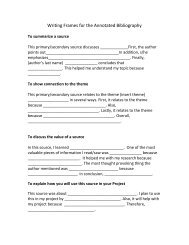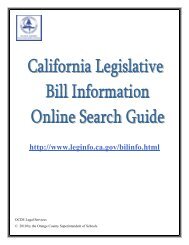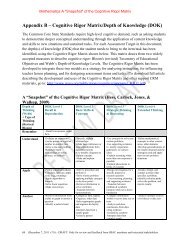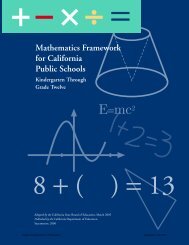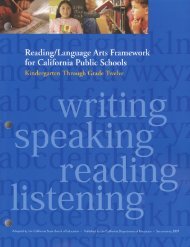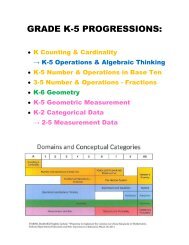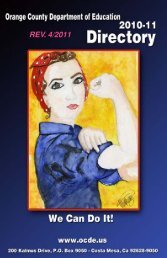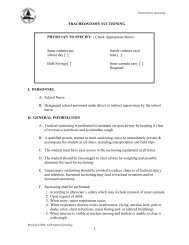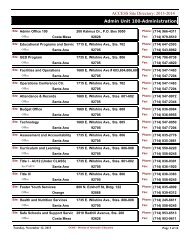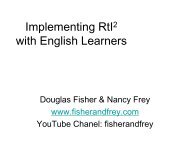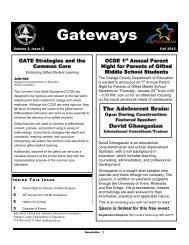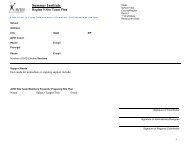The Promise and the Peril for Students with Disabilities - CalSTAT
The Promise and the Peril for Students with Disabilities - CalSTAT
The Promise and the Peril for Students with Disabilities - CalSTAT
Create successful ePaper yourself
Turn your PDF publications into a flip-book with our unique Google optimized e-Paper software.
Executive Function from page 13<br />
skills. Teachers <strong>and</strong> parents of children<br />
<strong>with</strong> disabilities <strong>and</strong> children from<br />
high-risk families can learn how to<br />
systematically <strong>and</strong> intentionally teach<br />
<strong>and</strong> support EF skills from birth.<br />
However, all teachers <strong>and</strong> parents can<br />
better support all children at every age<br />
by knowing about <strong>and</strong> implementing<br />
strategies to enhance <strong>the</strong> development<br />
of EF skills.<br />
Parents <strong>and</strong> educators can begin by<br />
looking at how <strong>the</strong>y interact <strong>with</strong> children,<br />
by making sure <strong>the</strong> environments<br />
<strong>the</strong>y create are caring <strong>and</strong> supportive,<br />
<strong>and</strong> by modeling—in what <strong>the</strong>y say<br />
<strong>and</strong> what <strong>the</strong>y do—what executive<br />
function looks <strong>and</strong> sounds like. Training<br />
that helps adults develop <strong>and</strong><br />
enhance environments that foster EF<br />
skills is an important step as well.<br />
A focus on executive function, built<br />
upon a working knowledge of how<br />
emotional development in young<br />
children shapes <strong>the</strong>ir cognitive development,<br />
can serve as a powerful tool<br />
to prepare children to come to school<br />
ready to learn <strong>and</strong> able to tackle rigorous<br />
st<strong>and</strong>ards. u<br />
<strong>The</strong> National Center <strong>for</strong><br />
Learning <strong>Disabilities</strong><br />
discusses executive function at<br />
www.ncld.org/ld-basics/ld-aampexecutive-functioning/basic-effacts/what-is-executive-function.<br />
In<strong>for</strong>mation on ADHD <strong>and</strong><br />
Executive Function<br />
is at www.<strong>the</strong>helpgroup.org/pdf/<br />
adhd-dys/brown_adhd.pdf.<br />
References<br />
Bierman, K. (2010). Promoting executive<br />
functions through prevention programs:<br />
<strong>The</strong> Head Start REDI program. [Power Point<br />
Slides]. Retrieved from www.nichd.nih.gov/<br />
about/meetings/2010/060810-bierman.cfm<br />
Council <strong>for</strong> Exceptional Children (2011).<br />
Improving executive function skills: An innovative<br />
strategy that may enhance learning<br />
<strong>for</strong> all children. Retrieved from<br />
www.cec.sped.org/AM/Template.cfm?Section<br />
=Home&CONTENTID=10291&CAT=none<br />
&TEMPLATE=/CM/ContentDisplay.cfm<br />
Siegel. D., & Bryson, T. (2011). <strong>The</strong> whole–brain<br />
child. New York, NY: Delacorte Press.<br />
<strong>The</strong> <strong>Promise</strong><br />
continued from page 7<br />
that are being developed to support<br />
educators <strong>and</strong> parents.<br />
2. Participate in professional development.<br />
Take part in professional<br />
development activities about <strong>the</strong><br />
CCSS whenever <strong>the</strong>y are offered.<br />
And, if you are a special educator, be<br />
sure that you participate in <strong>the</strong> same<br />
activities as your general education<br />
peers. Shared knowledge is essential<br />
to ensuring that everyone has <strong>the</strong><br />
CCSS in mind as <strong>the</strong>y educate students<br />
<strong>with</strong> disabilities.<br />
3. Adopt successful approaches. Focus<br />
on evidenced-based, successful<br />
practices <strong>for</strong> educating students <strong>with</strong><br />
disabilities in line <strong>with</strong> <strong>the</strong> CCSS.<br />
<strong>The</strong>se practices should be aligned<br />
throughout <strong>the</strong> system <strong>and</strong> must<br />
be practiced by administrators <strong>and</strong><br />
educators alike.<br />
<strong>The</strong> Center on Instruction<br />
offers school administrators <strong>and</strong> teachers<br />
numerous evidence-based resources<br />
<strong>for</strong> successful instructional practices:<br />
www.centeroninstruction.org/.<br />
4. Provide access to <strong>the</strong> general curriculum.<br />
Constantly think about what<br />
it means to have access to <strong>the</strong> general<br />
curriculum. This entails thinking<br />
about how to ensure that students<br />
<strong>with</strong> disabilities have access that<br />
meets <strong>the</strong>ir individual needs. It also<br />
includes thinking about <strong>the</strong> design<br />
of materials, how <strong>the</strong>y are presented,<br />
<strong>and</strong> how <strong>the</strong> student responds. And<br />
it means thinking in <strong>the</strong>se ways not<br />
just about instructional materials<br />
but about assessments as well.<br />
5. Monitor student progress <strong>and</strong><br />
adjust. Continuously check on how<br />
students are doing <strong>and</strong> <strong>the</strong> progress<br />
<strong>the</strong>y are making so that materials<br />
<strong>and</strong> procedures can be adjusted as<br />
needed. This practice should be applied<br />
<strong>for</strong> all students, but it is critical<br />
<strong>for</strong> students <strong>with</strong> disabilities.<br />
<strong>The</strong>se are some of <strong>the</strong> things that<br />
need to be undertaken so that students<br />
<strong>with</strong> disabilities can realize <strong>the</strong> potential<br />
promise of <strong>the</strong> CCSS. <strong>The</strong> time<br />
is right to ensure that each <strong>and</strong> every<br />
student <strong>with</strong> a disability can reach <strong>the</strong><br />
end of his or her high school years <strong>with</strong><br />
<strong>the</strong> knowledge <strong>and</strong> skills needed to be<br />
successful in <strong>the</strong> next phase of life, be it<br />
postsecondary education or a job. u<br />
References<br />
Bolt, S., & Roach, A.T. (2009). Inclusive assessment<br />
<strong>and</strong> accountability: A guide to accommodations <strong>for</strong><br />
students <strong>with</strong> diverse needs. New York: Guil<strong>for</strong>d<br />
Press. See also Laitusis, C.C., & Cook, L.L.<br />
(2007). Large-scale assessment <strong>and</strong> accommodations:<br />
What works? Arlington, VA: Council <strong>for</strong> Exceptional<br />
Children; Thurlow, M.L., Quenemoen,<br />
R.F., & Lazarus, S.S. (2011). Meeting <strong>the</strong> needs of<br />
special education students: Recommendations <strong>for</strong> <strong>the</strong><br />
Race to <strong>the</strong> Top consortia <strong>and</strong> states. Washington,<br />
DC: Arabella Advisors.<br />
Nolet, V., & McLaughlin, M.J. (2005). Accessing<br />
<strong>the</strong> general curriculum: Including students <strong>with</strong><br />
disabilities in st<strong>and</strong>ards-based re<strong>for</strong>m (2nd ed.).<br />
Thous<strong>and</strong> Oaks, CA: Corwin Press.<br />
Highlights of <strong>the</strong><br />
Smarter Balanced Assessment Consortium<br />
• 27 state members, 21 of which are Governing States <strong>and</strong> six of which are<br />
Advisory States (Cali<strong>for</strong>nia is a Governing State)<br />
• Two optional interim assessments (which include computer adaptive assessments<br />
<strong>and</strong> per<strong>for</strong>mance tasks)<br />
• Summative assessment in <strong>the</strong> last 12 weeks of <strong>the</strong> year (which includes per<strong>for</strong>mance<br />
tasks in reading, writing, <strong>and</strong> math, as well as a computer adaptive<br />
assessment <strong>with</strong> a re-take option)<br />
• Digital clearinghouse of <strong>for</strong>mative tools, processes, <strong>and</strong> exemplars; released<br />
items <strong>and</strong> tasks; model curriculum units; educator training; professional development<br />
tools <strong>and</strong> resources; interactive reporting system; scorer training<br />
modules; teacher collaboration tools<br />
Source: Center <strong>for</strong> K–12 Assessment <strong>and</strong> Per<strong>for</strong>mance Management at ETS (2012). Available at<br />
www.k12center.org.<br />
8 u <strong>The</strong> Common Core State St<strong>and</strong>ards Summer 2012 u <strong>The</strong> Special EDge




